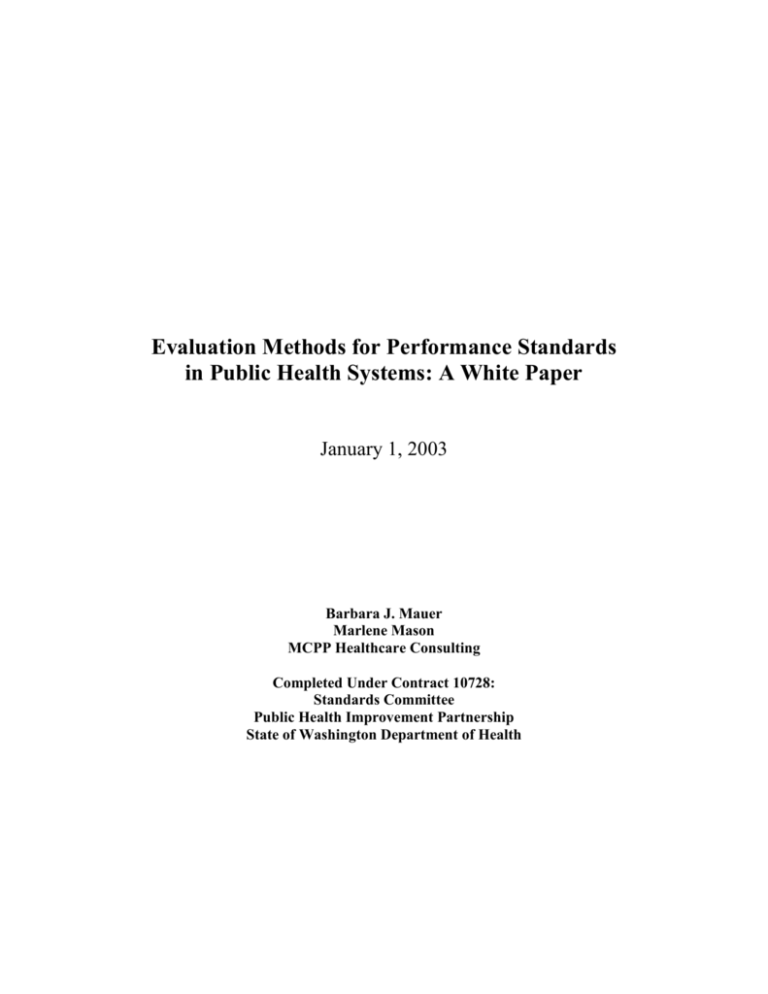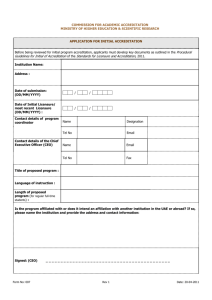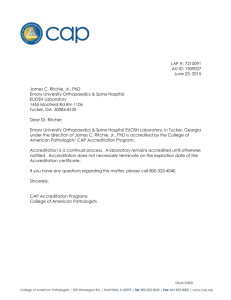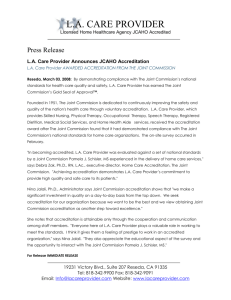The Baseline Evaluation
advertisement

Evaluation Methods for Performance Standards in Public Health Systems: A White Paper January 1, 2003 Barbara J. Mauer Marlene Mason MCPP Healthcare Consulting Completed Under Contract 10728: Standards Committee Public Health Improvement Partnership State of Washington Department of Health Table of Contents Background ............................................................................................................................................................3 Defining Performance Measurement ......................................................................................................3 Range of Approaches to Measuring the Performance of Systems ........................................4 Audits and Individual Program Evaluation................................................................................................................4 Accreditation or Certification Evaluations ................................................................................................................5 Stretch Standards ...................................................................................................................................................5 Evaluation of Selected Components ......................................................................................................................5 Type or Scope of Review ......................................................................................................................................6 Evidence of Application of an Improvement Cycle ...............................................................................................6 Quality Award Evaluation .........................................................................................................................................6 Uses of Accreditation and Other Evaluation Results .................................................................................................8 Application to Public Health Nationally ..............................................................................................8 Application to the Standards for Public Health in Washington State .................................9 The Baseline Evaluation ............................................................................................................................................9 Improvement or PDCA Cycle ...................................................................................................................................9 Scope of Review ...................................................................................................................................................... 10 Performance Standards in Public Health: Baseline Evaluation in Washington State 2 Background Public Health in the US has been measuring its performance for over 80 years. This evaluation has shifted back and forth between “doing things right” (counting visits and inspections and immunizations) and “doing the right things” (taking action on the analysis of community health assessments). Increasingly, the public health systems have moved toward the “doing the right things” end of the continuum – that is, measuring results as well as measuring resources and activities. In other words, measuring outcomes rather than just counting inputs and outputs. i In 1993, Washington State responded to the growing movement to measure public health as a system in order to improve overall public health protection and to identify exemplary practices. The Washington legislature enacted legislation to establish minimum public health standards and the State’s Public Health Improvement Plan (PHIP). In 1995 the Washington State legislature accepted the first PHIP and required performance-based contracts. By 1998 the PHIP contained a model of Standards for Public Health, using a framework of single performance standards for all parts of the state’s public health system, with unique local and state level measures to address the different responsibilities at local and state levels. After two intensive field tests of the standards and the measures themselves, the Standards Committee of the PHIP initiated the Baseline Evaluation of Public Health Performance Standards Project in the Spring of 2002. The Standards for Public Health in Washington State exemplify the national goals for public health performance measurement and development of standards—quality improvement, accountability, and science. The purpose of this review is to describe the relationship of the Standards for Public Health in Washington State to the framework of performance measurement approaches that have emerged for healthcare and public health organizations nationally, and to summarize the results of the 2002 Baseline Evaluation. Defining Performance Measurement To gain an overall perspective on measuring performance it is necessary to first understand what we mean when we use measurement language. The Guidebook for Performance Measurement produced in December 1999 by the Turning Point Project, a national collaborative of public health agencies, provides standard definitions of terms. According to the Guidebook: Performance measurement is the “regular collection and reporting of data to track work produced and results achieved”; Performance measure is “the specific quantitative representation of capacity, process, or outcome deemed relevant to the assessment of performance”; Performance standard is “ a generally accepted, objective standard of measurement such as a rule or guideline against which an organization’s level of performance can be compared”; Performance management is “the use of performance measurement information to help set agreed-upon performance goals, allocate and prioritize resources, inform managers to either confirm or change current policy or program directions to meet those goals, and report on the success in meeting those goals”; and, Performance measurement is “NOT punishment”. ii Performance Standards in Public Health: Baseline Evaluation in Washington State 3 Essentially, performance measurement analyzes the success of an organization’s efforts by comparing data on what actually happened to what was planned or intended. iii Performance measurement is not something done to you by someone else but something done together, in partnership, to improve your ability at every level – local, state, regional, and national – to achieve your common goals. Former Assistant Secretary for Health, Philip R. Lee (Guidebook for Performance Measurement) Range of Approaches to Measuring the Performance of Systems Audits and Individual Program Evaluation Audits for evaluating public health programs or healthcare providers have been used in healthcare for decades and have become more sophisticated over time. Audits have been the standard practice for determining whether contract or regulatory requirements were being met. These audits resulted in a listing of deficiencies, requirements for corrective action, and either a renewal or denial of contracts or licenses. Program evaluation requirements have been used in the last couple of decades to assess the extent to which programs are meeting goals and objectives, especially in regard to the effective use of public funds. In September of 1999 the Centers for Disease Control (CDC) released the Framework for Program Evaluation in Public Health. The framework was developed by a committee of public health and measurement experts to facilitate the integration of program evaluation throughout the public health system. The framework is a practical, non-prescriptive tool with six general steps for evaluating individual program performance. Program evaluations and audits are important in assessing the extent that a program meets its individual requirements. Effectively performing program evaluations is a necessary part of overall system performance measurement. An audit or individual program evaluation approach, however, is not effective in measuring the performance of large, multi-disciplinary organizations like hospitals, provider organizations, health plans and public health systems. As hospitals and other residential facilities began merging with outpatient care organizations and with physician groups to form large healthcare delivery systems, and as public health expanded the scope of services provided, it became clear that it would be impossible to improve the larger system with program level data. To look at every aspect of these large systems would be too burdensome and costly. Audits, due to their focus on single programs or projects, do not result in consistent system-wide information that will support improvement in system performance. For these purposes an accreditation or certification approach emerged as the most appropriate approach for evaluating the performance of large systems. Performance Standards in Public Health: Baseline Evaluation in Washington State 4 Accreditation or Certification Evaluations New approaches for evaluating the performance of larger organizational systems were developed, based on agreed-upon performance standards, by entities such as the National Committee for Quality Assurance (NCQA), HCFA (now Centers for Medicare & Medicaid Services [CMS]) and others. The Joint Commission on Accreditation of Hospitals (JCAH) incorporated new standards for larger, integrated care delivery systems and became JCAHO, the Joint Commission on the Accreditation of Healthcare Organizations. In contrast to contractual or regulatory audits, accreditation or certification may not be required for health organizations to continue operations (although it may be required as the basis for contracting with some payors). It is an additional, valuable indication of the quality of the care and service provided by the health system. These accreditation entities differ from traditional auditing entities in their approach to measuring the performance of the system, and in the results of the evaluation. Accreditation entities encompass a wide range of approaches to evaluating performance, but have some common factors. External accreditation entities are hired by the subject organizations to evaluate the overall performance of the system and to confer a level of performance against the standards. There are usually no “corrective actions” required by accreditation organizations although JCAHO does make recommendations for improvement and does require progress reports on these issues in order for the organization to maintain JCAHO accreditation. All accreditation entities deliver comprehensive performance reports to the organization and confer independent accreditation status to the organization. Stretch Standards Because the results of accreditation system evaluations are primarily for improving the performance of the system, the performance standards do not describe the system exactly as it is performing at the current time. The standards articulate a higher level of performance, often described as “stretch” standards. It is important that the standards and measures are not all immediately attainable by all parts of the system. Stretch standards and measures also provide a more stable measurement tool that can yield comparable results over the course of several evaluation cycles. Developing a model to predict and describe public health capacity is not the primary purpose of the performance standards process. Existing survey instruments already accomplish this purpose. Instead, the performance standards tools should provide a road map that can be used by public health organizations to establish measurable goals and objectives for system improvement.” Paul K. Halverson Public Health Management and Practice, September 2000 Evaluation of Selected Components Accreditation evaluations also differ from traditional audits in that they do not evaluate all units or programs for each of the identified standards. For example, NCQA has a standard that addresses health management programs. While a health plan being reviewed by NCQA may, in fact, conduct 6 or 7 different health management programs, NCQA surveyors evaluate two selected programs for their performance against the standards. Similarly, during a JCAHO Performance Standards in Public Health: Baseline Evaluation in Washington State 5 survey, the reviewers may review only half or two-thirds of the organization’s practitioner sites to evaluate the overall practitioner site performance against the applicable JCAHO standards. When accreditation status is awarded, there is no distinction made regarding the number of program and/or site reviews in one organization compared to another, leading to the accreditation—comparability is assumed. Type or Scope of Review Another important concept used in accreditation processes is the extent of the review for each measure. The most common type of review is called a SAMPLE. For sample review measures, only some of the components or programs are evaluated against the measure. For some measures the reviewers may be required to evaluate every component selected for the evaluation against that measure. This type of review is called ALL. The final type of review is the measure that can be evaluated once for the entire organization and is called a ONCE type of review. Evidence of Application of an Improvement Cycle Accreditation-type standards and measures often reflect an improvement cycle such as Plan-DoCheck-Act (PDCA) for each topic that they address. For example, the NCQA standards and measures for clinical guidelines include requirements for evidenced-based clinical practice guidelines (CPGs). These CPGs are the plan step of the cycle. The next measure requires the distribution of the CPG to providers (the do step), then the measurement of provider compliance with the guideline (the check step), and the review and updating of the CPGs (the act step). This application of the improvement cycle in the standards and measures themselves is a unique and critical part of accreditation and certification programs. A performance standards system therefore is not simply a report card for public health organizations. Rather, performance standards are tools that public health professionals can use to build infrastructure by informing ourselves, our policy makers, and our constituents about the strengths and weaknesses in our systems. Paul K. Halverson, Editorial Public Health Management and Practice, September 2000 Quality Award Evaluation Another approach to performance evaluation is the quality award system represented by the Baldrige Criteria for Performance Excellence. The Baldrige process of evaluation, developed in the late 1980s, uses an external team consensus model to determine how systematic the organization’s approach to the evaluation item is and the extent of deployment of that approach in six categories of criteria. The seventh category is the evaluation of the results achieved by the organization. An organization applies to be evaluated for a Baldrige Quality Award and only the organizations that achieve high performance against the criteria receive an award. All other applicants simply receive a written report. What the organization does with the written results is completely up to the leadership of the organization. Most importantly, there is no information that tells any outside entity how the organization performed, or how that might be related to the performance of similar organizations. The award winning organization must communicate any and all information about their operations and outcomes themselves. In order for people from Performance Standards in Public Health: Baseline Evaluation in Washington State 6 another organization to build upon the achievements of the award winner, they must conduct a site visit to understand the award winner’s work processes and strategies for success. Other differences among these performance measurement approaches are described below. Regulatory or Contractual Audits Program Evaluation Accreditation or Certification Processes To demonstrate the quality of system or of the care and services by achieving high level of accreditation Quality Award Purpose To meet requirements in order to continue contract, comply with regulations, or to renew license To assess the program’s effectiveness in meeting established goals and/or objectives Evaluation entity Individual program or specific component of a larger organization Specific program within an organization Numerous, selected programs or components representing the entire organization All components of a major division or an entire organization Who chooses entities and timing of evaluation Regulator or contractor determines scope and timing of evaluation Oversight entity or the program leadership Organization determines scope and timing of evaluation Organization applies for review to be considered for award Evaluation system Auditors determine compliance against contract requirements, laws or regulations Evaluators determine extent to which program is meeting goals and objectives, ideally related to service outcomes Surveyors evaluate performance against a set of standards and measures developed through multidisciplinary process Team of examiners reaches consensus on performance against a set of established criteria Results Written report with list of deficiencies and required corrective actions Written report, often annual or more frequent, with summary of findings and extent that goals and objectives are being achieved Level of performance on standards and accreditation status. No follow-up, but accreditation can be denied. All receive written report Only organizations that achieve a high level of performance receive award. All receive written report Uses of results Corrective Action Plan (CAP), and determination of continuation of contracts Actions for improvement to address goals and objectives that are not being met Improvement of system’s processes and outcomes. Establishment of exemplary or best practices Award winners Performance Standards in Public Health: Baseline Evaluation in Washington State To demonstrate high quality across the organization’s systems to receive quality award 7 Uses of Accreditation and Other Evaluation Results Two of the primary uses for results of program evaluations, accreditation or quality awards are for (1) making comparisons of performance levels and (2) improving the quality of the processes and outcomes of the organization. For comparison purposes, the standards and measures should provide sufficiently valid and reliable quantification such that comparison across the system’s programs and departments can be made. By identifying the highest level of performance or outcome (the benchmark), an organization can duplicate those work processes to achieve higher performance overall. For improving quality, some standards and measures lend themselves more to internal monitoring of performance and local accountability and are most suitable for supporting the improvement of the organization rather than for comparability among organizations. The American College of Mental Health Administration (ACMHA) has applied these distinctions between comparison and quality improvement in a proposed Consensus Set of Indicators for Behavioral Health. In this project, five national accreditation entities (CARF [The Rehabilitation Commission], the Council on Accreditation, the Council on Quality and Leadership in Support of Persons with Disabilities, JCAHO and NCQA) reached consensus on a set of performance measures. They concluded that it was “important to recognize that selecting appropriate measures depends on the purpose of assessing performance. For example, one purpose would be for determining quality improvement needed and another purpose is to hold providers accountable for the care being given.” They have designated measures as either a comparison measure or a quality improvement measure to clarify the intended use of each measure and its data set. iv Application to Public Health Nationally In 1997 the CDC established the Public Health Practice Program Office (PHPPO) to address the initiative to advance the capacity of state and local public health systems in the US. Along with the CDC and several key associations such as the National Association of County and City Health Officials (NACCHO) and the American Public Health Association (APHA), the PHPPO created the National Public Health Performance Standards Program. Improving quality is the overriding emphasis within the Standards Program; it is meant to stimulate a deliberate focus on improving the capacity of public health systems to provide the essential services of public health. v Recently the partnership released separate sets of performance standards for local public health governance, for local jurisdictions and for state level programs. The standards are based on the core public health functions of Assessment, Policy Development and Assurance, as well as the nationally recognized ten essential services related to each of these core functions. These instruments use a self-assessment form of evaluation in which the entity evaluates itself against standards that describe an aspect of optimum performance on an indicator. Measures and submeasures in the form of questions guide the self-evaluator through the set of standards and indicators. The result is then ranked on a percentile basis. Performance Standards in Public Health: Baseline Evaluation in Washington State 8 These standards and measures are a mixture of the accreditation model and the quality award model described above, although the self-assessment aspect represents a significant variation from these models. The performance measurement approaches described above do not generally use a self-assessment type of evaluation. The Council on Accreditation does have an explicit step of self-assessment and system improvement prior to the accreditation survey. Most organizations preparing for JCAHO or NCQA surveys also perform a “mock” assessment as a part of their preparation activities. The actual review, however, is performed by outside surveyors. Application to the Standards for Public Health in Washington State Public health managers and staff are very familiar with program audits and more traditional types of quality assurance. Program audits continue to be a valuable method for evaluating individual program compliance with contract and licensure requirements. However, the Standards were adopted in this context—“It is expected that some standards will be beyond reach for some time to come. Yet, even these unmet standards will provide an important guidepost for our future and a way to measure progress as we work toward meeting them”. vi The Baseline Evaluation To evaluate the performance of Washington’s entire public health system, both state and local levels, a systems evaluation approach was selected. The Standards Committee contracted with external reviewers to conduct an accreditation type of evaluation, rather than relying on a selfassessment model. The Standards Committee and the leadership of the Department of Health (DOH) and the Washington State Association of Local Public Health Officials (WSALPHO), through the reviewer selection process, specified which parts of the system they wanted to have evaluated. This translated into a baseline evaluation of 38 state-level programs located in five divisions and all (34) of the local health jurisdictions (LHJs) in the state. The site reviewers used the Standards to conduct the baseline evaluation of the selected parts of the statewide system (this is the “organization” being reviewed). The selected DOH programs and the LHJs could not choose which standards and measures to be evaluated against. For the LHJs, each measure was considered applicable. For DOH programs, applicability of each measure to each program was established in advance of the site visits. The baseline evaluation included a self-assessment step in which each site completed a self-assessment tool regarding each applicable measure. Each site was asked to prepare for an on-site visit by organizing the documentation supporting the self-assessment on each measure. The site reviewer then evaluated the documentation and scored each measure. Improvement or PDCA Cycle Washington’s public health performance standards and measures reflect an improvement cycle, as discussed above. An excellent example is the set of measures for communicable disease reporting and investigation. Written protocols are required for receiving and managing the communicable disease reports (the plan step). Several measures describe the requirements for communicating with providers and with law enforcement as well as training of local public Performance Standards in Public Health: Baseline Evaluation in Washington State 9 health staff (the do step). Then a tracking system with at least annual evaluation of key indicators is required, as well as a debriefing process for major outbreaks (the check step). Finally, the implications for investigations, intervention, or educational efforts are measured (the act step). The improvement cycle is evident in many of the topics that are measured in Washington’s standards for public health, and is demonstrated in the overall process for implementing the Standards. Plan Draft Standards Act Committee action Plan Revised Standards Do Evaluate Check Report/Recommend Standards Development and Evaluation 2000 - 2001 Act Recommend Improvement Do Understand Standards/Self Assessment Plan Plan Improvements Act Recommend Improvement Do Implement Improvements Check Site visit & Report Check Site visit & Report Baseline Evaluation of Standards 2002 Improvement Cycle 2003-2004 Scope of Review Washington’s performance standards also contain the three types of measures described earlier as SAMPLE, ALL, and ONCE. For SAMPLE review measures, only some of the DOH programs are evaluated against any given measure. In preparing the self-assessment, each DOH program or LHJ identified the program materials that would best demonstrate a measure. In future cycles, additional programmatic materials may be requested. It has been generally agreed that no organization in the system can demonstrate applicable measures in all areas of their work—this is another one of the ways in which these are stretch standards. An example of an ALL measure is the measure requiring that all DOH staff and that all key LHJ staff be trained in emergency response plans. None of the programs or LHJs being reviewed can be excluded from being evaluated for this measure. An example of the ONCE type of measure is the access measure that requires a single list of critical health services for the entire public health system. The reviewers need only to see this list once to evaluate performance for the entire organization. Individual programs within DOH do not need to demonstrate performance against this part of the measure once DOH overall has demonstrated it. During the Baseline Evaluation, when a specific DOH program could not fully meet the established measure without the direct contribution of several other programs the measure was called a “partnership measure” Some examples of partnership designation included: multiple programs contributed to a single product; components of the measure clearly required different Performance Standards in Public Health: Baseline Evaluation in Washington State 10 pieces from different programs; or, there was a reference to a single or standard process or protocol. In the future, these DOH partnership measures will be the basis for ONCE measures, where the materials need to be presented once in the organization, not prepared, viewed and scored multiple times in multiple programs. i Lichiello, Patricia; Turning Point Guidebook for Performance Measurement, Turning Point National Program Office, December 1999. ii Ibid iii Ibid iv Adams, Morris, et al; A Proposed Consensus Set of Indicators for Behavioral Health, The American College of Mental Health Administration, February 2001 v Halverson, Paul K.; Performance Measurement and Performance Standards: Old Wine in New Bottles, Journal of Public Health management and Practice, vol.6, No.5, September 2000 vi National Public Health Performance Standards Program webpage, www.naccho.org/project48.cfm Performance Standards in Public Health: Baseline Evaluation in Washington State 11








